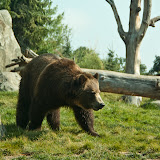The Minnesota Zoo (in Minneapolis / St. Paul) is quite a nice zoo. It's not huge in terms of numbers of animals, but it's in quite a large park-like area with lots of trees and ponds. And the animal enclosures are quite large and natural - not too many overt bars and cages. They also had a good butterfly exhibit (as you can tell by the photos!).
 |
| 2009-08 Minnesota Zoo |
The only negative was when I came out the main gate to find these signs:
 The zoo may not have done this themselves, they may contract out the grounds maintenance. Maybe it wasn't even zoo property, although it was immediately outside the gate. Even so, for a place like this, that makes a big deal out of conservation and protecting the environment, it seems a little contradictory to be spraying poison around within 100 yards of animal enclosures. Not to mention all the kids and babies passing by going in and out of the zoo.
The zoo may not have done this themselves, they may contract out the grounds maintenance. Maybe it wasn't even zoo property, although it was immediately outside the gate. Even so, for a place like this, that makes a big deal out of conservation and protecting the environment, it seems a little contradictory to be spraying poison around within 100 yards of animal enclosures. Not to mention all the kids and babies passing by going in and out of the zoo.I emailed the zoo about this, but got no response. (I know they received it because they had problems receiving the photo.) This seems to be the norm when you report issues to most organizations. I can't understand it - it seems so totally "wrong" to me. How hard is it to reply? Even if it's just to say "we received your message". It wouldn't even cost them anything to say they'll look into it. To me, the worst possible response is to ignore it, or at least to appear to be ignoring it. I can't imagine that my software business would have survived if we had ignored customers reporting problems.
I even told them I'd be blogging about it and that I'd be happy to include their response. I thought that might help elicit a reply, but I guess that was wishful thinking.
Of course, I got home to find similar signs on the park half a block from my house, only this time they were poisoning the gophers. Even if you have no qualms about poisoning gophers, do you really want poison that kills small mammals being sprayed all over where your kids play? I'm sure the chemical company says it's safe, but given their track records I wouldn't put a lot of faith in that. Personally, I enjoy seeing the gophers and their antics and I'm not sure what they're hurting. Obviously they offend some people. Some of those people offend me, but I'm not allowed to poison them.


